
Algunos sueños son los "motores" del futuro.
Pero claro no todos los sueños funcionan así y acaban siendo realidades. En la mayoría de los casos acaban siendo… “castillos en el aire”. Esto suele deberse a que convertir un sueño en realidad no es una tarea fácil. Estas tareas requieren una fuerte determinación, una perseverancia infinita y, principalmente, la buena gestión de tres condiciones generales.
Para convertir un sueño en realidad, la primera condición para empezar es construir un “terreno sólido”. Y a esto hay que sumar dos requisitos más. La primera (o segunda) es utilizar "buen material", el mejor material que existe para construir "el castillo". Todos los raws tienen que encajar, ser robustos y consistentes. Y el segundo (el tercero del total), utilizar “las mejores manos” para colocar todo en la forma correcta.
En el mundo real, la energía fotovoltaica es un buen ejemplo de sueño colectivo. Para muchas personas la posibilidad de vivir de la energía del sol es uno de sus sueños más anhelados. Para hacerlo realidad, muchos técnicos, de diferentes disciplinas, se comprometen cada día a conseguir algo más a favor del sueño.
En general, y desde el punto de vista técnico, algunos de los retos son: sacar más partido a los paneles solares cada año, hacer que duren más en el tiempo (años), poder captar y distribuir energía de manera eficiente. y hacer que todo esto sea económicamente posible. Mucho trabajo dividido.
En este esfuerzo conjunto, cada uno de nosotros busca cómo aportar algo mejor y/nuevo como nuestro aporte particular. Veamos algunos ejemplos particulares que provienen de fabricantes de encapsulantes y células de silicio.
Algunos esfuerzos de los fabricantes de células....
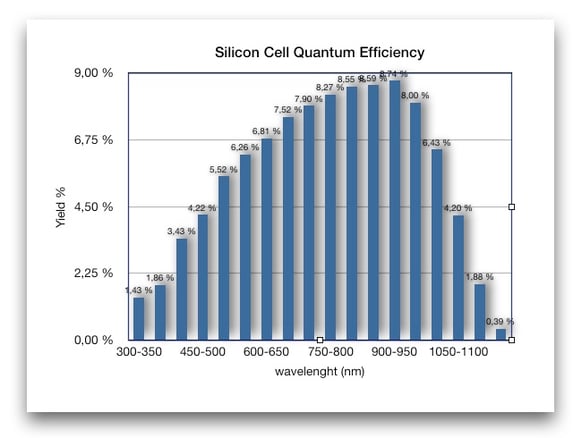
-
Some cell manufacturers are looking to find the manera de aumentar la eficiencia cuántica de las células. En su camino tienen que encontrar respuestas a preguntas como:
¿Qué hacer para aumentar un 10, 15 o 20% en cada rango de longitud de onda? ¿Es posible hacerlo sólo en una longitud de onda selectiva...?
¿Cómo aumentar la eficiencia celular aumentando la conectividad celular? ¿Y si aumentamos la conectividad de las células? ¿Cómo calcular celdas con 4 o 6 barras? ¿Cuáles serán las mejoras? ¿Qué tan sostenibles serán?
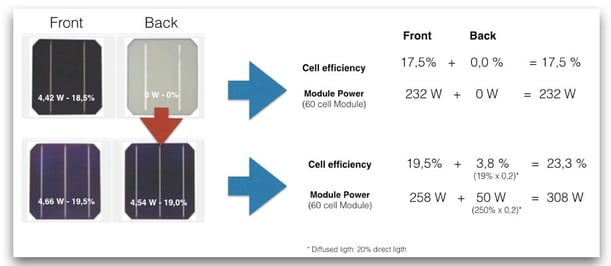
- Otras personas buscan células bifaciales. Sueñan con aportar algunas soluciones para poder construir edificios inteligentes con fachadas activas que produzcan energía.
Para alcanzar estos objetivos también es necesario resolver algunos avances en materiales y procesamiento. La posibilidad de fabricar elegantes módulos de vidrio es hoy un hermoso sueño. Además: ¿Cómo integrar estos módulos con sensores y dispositivos de iluminación convirtiendo elementos arquitectónicos pasivos en dispositivos inteligentes? Aún queda camino por recorrer para llegar al grano.
Algunos esfuerzos de encapsuladores de películas...
Los fabricantes de encapsuladores también están realizando otros esfuerzos.
- Una idea que teníamos era producir un encapsulante capaz de reconvertir una porción importante del espectro electromagnético incidente en diferentes bandas de longitudes de onda absorbidas de manera más eficiente por las fotocélulas. Tuvimos este sueño hace algún tiempo e hicimos algunos esfuerzos para hacerlo realidad. Lo intentamos seriamente, pero lamentablemente técnicamente no tenemos listo el material adecuado. Los aditivos utilizados para reconvertir las bandas de longitud de onda no eran resistentes a los efectos nocivos de la radiación ultravioleta. Por eso hoy esto sigue siendo un sueño abierto que busca una estructura mucho más consistente. Tenemos una base sólida, buenas manos pero no tenemos los materiales consistentes que necesitamos...
- Otra idea que algunas personas están tratando de promover estos días es abrir la ventana de radiación UV en los encapsulantes de EVA (permitiendo que la radiación UV pase a través del EVA y llegue a las células) para que pueda aumentar en aproximadamente un 1%. del rendimiento de cada celda.
En nuestra opinión, esta idea es otra que no está bien fundamentada en el hecho de que el EVA es un material sensible a los rayos UV. Y recordemos que desde hace 10 años trabajamos para protegerte contra los daños de la radiación UV. Durante mucho tiempo nuestro desafío fue poder mantener el módulo en funcionamiento durante 20 años sin que el EVA amarilleara y se degradara. Pasamos varios años mejorando la vida útil de los módulos y ahora estamos considerando tener un EVA desprotegido, ¿diciendo que tenemos un nuevo "encapsulante de EVA de alto rendimiento"? . Una vez más, en nuestra opinión, esta no es una actitud justa y parece más un juego de estrategia de mercado y ventas que una mejora de la calidad y el rendimiento.
Cuando decimos que esta idea no es inteligente es porque, como todos los amantes de los polímeros saben, no tenemos el material adecuado para que esto suceda. La solución no es sólo cuestión de cambiar los aditivos que absorben los rayos UV en la matriz de EVA. Al cambiar los estabilizadores UV podemos ralentizar el proceso de degradación del EVA pero no podemos evitar completamente el problema porque el EVA es el polímero que es. La solución a este problema sólo puede pasar por un cambio dramático, como cambiar el material encapsulante… pero este es otro caso que no vamos a tratar aquí.
Pasando a los detalles técnicos que respaldan nuestras palabras, debemos fijarnos en el siguiente gráfico. Este gráfico presenta el % de transmitancia versus longitudes de onda de una película de EVA sin protección UV (el gráfico verde. EVA no estabilizada contra los rayos UV) y una película de EVA protegida contra los rayos UV (el gráfico rojo. EVA estabilizada contra los rayos UV con un corte en una longitud de onda de 350 nm). EVA es sensible al rango de radiación de 240 a 350 nm (todo el rango UV). Al jugar con películas de EVA con un corte inferior a 350 nm, estamos desafiando la vida útil del módulo. Al utilizar un EVA con un corte de 300 nm, estamos desprotegiendo el EVA entre el rango de 300 a 350 nm (desde la línea de puntos roja hasta la línea roja). Eso significa que estaríamos usando un EVA 1/2 protegido. En nuestra opinión, esta es una decisión de alto riesgo, especialmente para paneles que tienen que trabajar en zonas de gusanos del mundo donde la radiación UV normalmente es muy intensa. La pregunta es: ¿la ganancia de menos del 1% en eficiencia de la célula se va a ver compensada por la reducción de la vida útil del panel fotovoltaico?
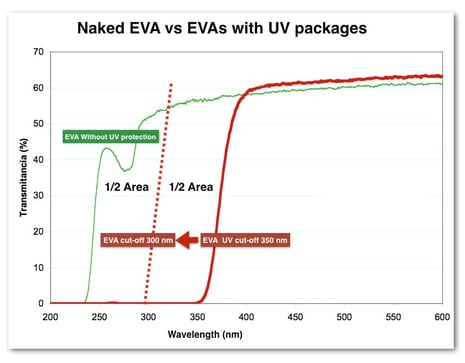
¿Cómo se degrada el EVA debido a la radiación UV?
Es un proceso de degradación química que implica la descomposición de pequeños trozos de macromoléculas de EVA, formando diferentes subproductos que pueden ser monitorizados mediante diferentes técnicas analíticas como FTIR (espectrometría infrarroja por transformada de Fourier). Los siguientes espectros muestran los cambios de monitoreo que tienen lugar a medida que evoluciona la degradación.
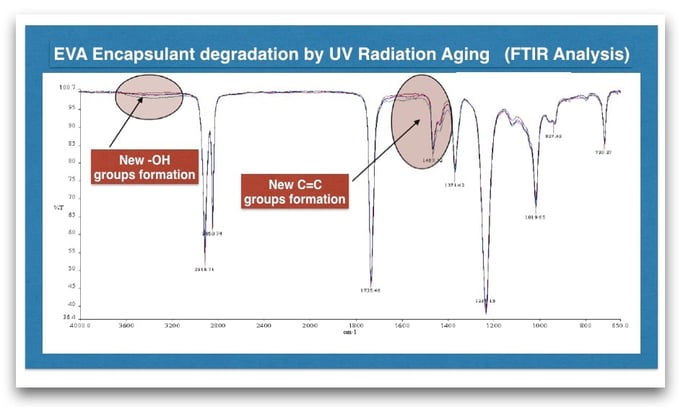
A modo de resumen, no debemos olvidar que el EVA, al igual que la epidermis de nuestra piel, es un material orgánico y, como tal, es sensible a la radiación UV. Tanto la epidermis como el EVA no son en absoluto sensibles, de hecho son materiales muy sensibles que necesitan una protección especial contra los rayos UV. Del mismo modo cuando vamos a la playa debemos utilizar cremas UV para protegernos de terribles quemaduras (piel enrojecida), el EVA hay que protegerlo utilizando estabilizadores UV contra su degradación (el efecto amarillento). Además, la degradación del EVA genera ácido acético que reacciona químicamente con las conexiones metálicas del interior de los paneles.
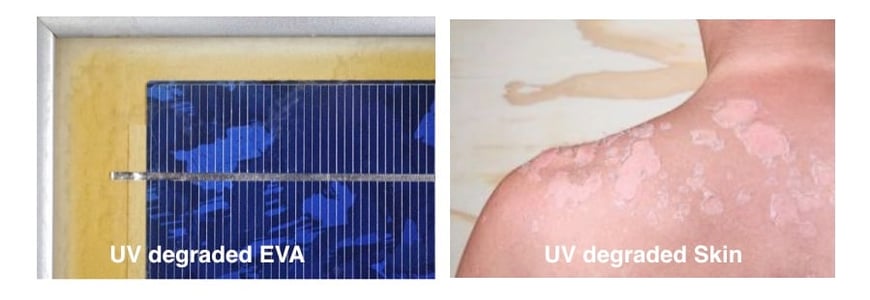
Dicho todo esto, consideramos que este tipo de propuestas y prácticas son acciones injustas contra los sueños y bolsillos de muchas personas. Los sueños sólo pueden hacerse realidad si están cimentados en tierra firme, construidos con "materiales" fuertes y con manos cuidadosas.
CATEGORIES:
Fotovoltaicadiciembre 21, 2023